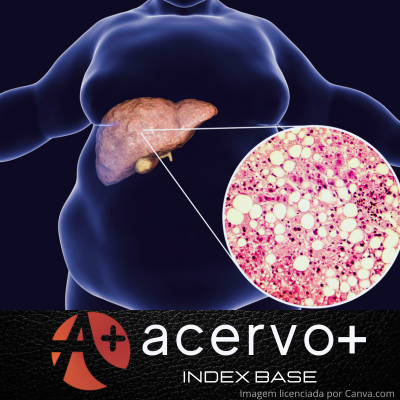Relação entre a obesidade infantil e doença hepática gordurosa não alcoólica
##plugins.themes.bootstrap3.article.main##
Resumo
Objetivo: Compreender a relação entre obesidade infantil e Doença hepática gordurosa não alcoólica (DHGNA), através da reunião de conteúdos que ampliam o tema desta revisão. Métodos: Trata-se de uma revisão integrativa, baseada na plataforma de pesquisa PubMed e SCIELO, utilizando os descritores "Obesidade infantil" e "Doença hepática gordurosa não alcoólica" e "esteatose" e operador booleano “AND” e “OR”, com artigos publicados de 2018 a 2024, em inglês, que possuíssem maior relevância e atualidade. No total da análise, contabilizou-se 10 artigos para serem incluídos como base do presente estudo. Resultados: A DHGNA em crianças e adolescentes é uma patogênese complexa, em que há predisposições multifatoriais que podem alterar o metabolismo dos lípidos e do açúcar no fígado. É subdiagnosticada, deve-se rastrear crianças com obesidade, hipertensão, resistência à insulina, diabetes, pré-diabetes, adiposidade central e dislipidemia. Diagnóstico e o manejo precoces serão a única forma de enfrentar a doença. Mudar o estilo de vida permanece como a base do tratamento para a DHGNA. Considerações finais: Sugere-se estudos a longo prazo, para melhorias de diagnóstico e intervenção medicamentosa, a fim de haver maior promoção em saúde para o público infantil e impacto na vida adulta.
##plugins.themes.bootstrap3.article.details##
Copyright © | Todos os direitos reservados.
A revista detém os direitos autorais exclusivos de publicação deste artigo nos termos da lei 9610/98.
Reprodução parcial
É livre o uso de partes do texto, figuras e questionário do artigo, sendo obrigatória a citação dos autores e revista.
Reprodução total
É expressamente proibida, devendo ser autorizada pela revista.
Referências
2. BRUNNER KT, et al. Nonalcoholic fatty liver disease and obesity treatment. Current obesity reports, 2019; 8(3): 220-228.
3. CHACÓN C, et al. Clinical epidemiology of non-alcoholic fatty liver disease in children and adolescents. The LiverKids: Study protocol. Plos one, 2023; 18(10): 0286586.
4. CUZMAR V, et al. Early obesity: risk factor for fatty liver disease. Journal of Pediatric Gastroenterology and Nutrition, 2020; 70(1): 93-98.
5. DISTEFANO JK e SHAIBI GQ. The relationship between excessive dietary fructose consumption and paediatric fatty liver disease. Pediatric obesity, 2021; 16(6): 12759.
6. DRAIJER L, et al. A natural history study of paediatric non-alcoholic fatty liver disease over 10 years. JHEP Reports, 2023; 5(5): 100685.
7. FANG YAN-LAN, et al. Pathogenesis of non-alcoholic fatty liver disease in children and adolescence: From “two hit theory” to “multiple hit model”. World journal of gastroenterology, 2018; 24(27): 2974-2983.
8. FERREIRA S, et al. Nonalcoholic fatty liver disease and continuous metabolic syndrome in adolescents with overweight/obesity. Acta Medica Portuguesa, 2024; 37(3): 177-186.
9. GARIBAY-NIETO N, et al. Metabolomic Phenotype of Hepatic Steatosis and Fibrosis in Mexican Children Living with Obesity. Medicina, 2023; 59(10): 1785.
10. GOLDNER D e LAVINE JE. Nonalcoholic fatty liver disease in children: unique considerations and challenges. Gastroenterology, 2020; 158(7): 1967-19831.
11. HASHEM A, et al. Management of obesity and nonalcoholic fatty liver disease: A literature review. In: Seminars in liver disease. 333 Seventh Avenue, 18th Floor, New York, NY 10001, USA: Thieme Medical Publishers, Inc, 2021; 41(4): 435-447.
12. KARAIVAZOGLOU K, et al. Psychosocial issues in pediatric nonalcoholic fatty liver disease. Psychosomatics, 2019; 60(1): 10-17.
13. KO JS. New perspectives in pediatric nonalcoholic fatty liver disease: epidemiology, genetics, diagnosis, and natural history. Pediatric Gastroenterology, Hepatology & Nutrition, 2019; 22(6): 501-510.
14. LIN CHUAN-HAO e KOHLI R. Emerging new diagnostic modalities and therapies of nonalcoholic fatty liver disease. Current Gastroenterology Reports, 2020; 22(10): 52.
15. MARUSZCZAK K, et al. Determinants of hyperglucagonemia in pediatric non-alcoholic fatty liver disease. Frontiers in Endocrinology, 2022; 13: 1004128.
16. MAZHAR K. The future of nonalcoholic fatty liver disease treatment. Medical Clinics, 2019; 103(1): 57-69.
17. MOGAHED EA, et al. Causes of secondary non-alcoholic fatty liver disease in non-obese children below 10 years. European journal of pediatrics, 2020; 179(5): 719-726.
18. NERI CR, et al. Liver steatosis: a marker of metabolic risk in children. International Journal of Molecular Sciences, 2022; 23(9): 4822.
19. NEWTON KP, et al. Incidence of type 2 diabetes in children with nonalcoholic fatty liver disease. Clinical Gastroenterology and Hepatology, 2023; 21(5): 1261-1270.
20. POLYZOS SA, et al. Obesity and nonalcoholic fatty liver disease: From pathophysiology to therapeutics. Metabolism, 2019; 92: 82-97.
21. QUERTER I, et al. Maternal and perinatal risk factors for pediatric nonalcoholic fatty liver disease: a systematic review. Clinical Gastroenterology and Hepatology, 2022; 20(4): 740-755.
22. SMITH SK e PERITO ER. Nonalcoholic liver disease in children and adolescents. Clinics in liver disease, 2018; 22(4): 723-733.
23. SPIEZIA C, et al. Nutritional Approaches in Children with Overweight or Obesity and Hepatic Steatosis. Nutrients, 2023; 15(11): 2435.
24. ZHANG PING-PING, et al. Lifestyle intervention in children with obesity and nonalcoholic fatty liver disease (NAFLD): study protocol for a randomized controlled trial in Ningbo city (the SCIENT study). Trials, 2024, 25(1): 196.

